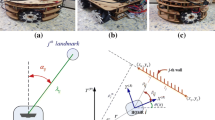Abstract
A method of cooperative localization for multi-robot in an unknown environment is described. They share information and perform localization by using relative observations and necessary communication. At initial time, robots do not know their positions. Once the robot that can obtain the absolute position information has its position, other robots use particle filter to fuse relative observations and maintain a set of samples respectively representing their positions. When the particles are close to a Gaussian distribution after a number of steps, we switch to an EKF to track the pose of the robots. Simulation results and real experiment show that PF-EKF method combines the robustness of PF and the efficiency of EKF. Robots can share the absolute position information and effectively localize themselves in an unknown environment.
Similar content being viewed by others
Reference
Cao Y U, Fukunaga A S, Kahng A B. Cooperative mobile robotics: antecedents and directions. Autonomous Robots, 1997, 4(1): 7–27
Stroupe A W, Martin M C, Balch T. Distributed sensor fusion for object position estimation by multi-robot systems. In: Proceedings of the IEEE International Conference on Robotics and Automation (ICRA’01), Seoul, Korea, May 2001. 1092–1098
Rekleitis I M, Dudek G, Milios E E. Multi-robot cooperative localization: a study of trade-off between efficiency and accuracy. In: Proceedings of the IEEE International Conference on Intelligent Robot and Systems (IROS02), Lausanne, Switzerland, Sep. 30–Oct. 5, 2002. 2690–2695
Martinelli A, Pont F, Siegwart R. Multi-robot localization using relative observations. In: Proceedings of the IEEE International Conference on Robotics and Automation, Barcelona, Spain, April 2005
Roumeliotis S I, Bekey G A. Distributed multirobot localization. IEEE Trans Robot Autom, 2002, 18(5): 781–795
Fox D, Burgard W, Kruppa H, et al. A probabilistic approach to collaborative multi-robot localization. Special Issue of Auton Robot Heterogeneous Multi-Robot Syst, 2000, 8(3): 325–344
Howard A, Mataric M J, Sukhatme G S. Localization for mobile robot teams: a distributed MLE approach. Experim Robot, 2003, 5: 146–155
Howard A, Mataric M J, Sukhatme G S. Cooperative relative localization for mobile robot teams: an EGO-Centric approach. In: Proceedings of Naval Research Laboratory Workshop on Multi-Robot Systems. Washington DC, March 17–19, 2003. 65–76
Montesano L, Gaspar J, Santos-Victor J, et al. Cooperative localization by fusing vision-based bearing measurements and motion. In: Proceedings of the IEEE/RSJ International Conference on Intelligent Robots and Systems (IROS’05), August 2005. 19–24
Merwe R V D, Doucet A. The unscented particle filter. Adv Neural Infor Proc Syst. MIT, 2000
Yuan Z J, Zheng N N, Jia X C. The Guass-Hermite particle filter. Acta Elec Sin, 2003, (7): 970–973
Li S, Xu X M, Ye B, et al. International RoboCup and the technologies. Robot, 2000, 22(5): 420–426
Liu Y P. The design of multi-sensor system and the implementation in robot localization. Master thesis. National University of Defense Technology, Changsha, Hunan, 2005. 10
Hao Y M, Dong Z L, Meng K. An omnidirectional location system for autonomous mobile robot. 30th ISR, Japan, 1999
Author information
Authors and Affiliations
Corresponding author
Additional information
Supported partially by the Ministry Research Fund Project (Grant No. 51416070305KG0180) and the National Natural Science Foundation of China (Grant Nos. 60675056 and 60334010)
Rights and permissions
About this article
Cite this article
Wang, L., Wan, J., Liu, Y. et al. Cooperative localization method for multi-robot based on PF-EKF. Sci. China Ser. F-Inf. Sci. 51, 1125–1137 (2008). https://doi.org/10.1007/s11432-008-0041-1
Received:
Accepted:
Published:
Issue Date:
DOI: https://doi.org/10.1007/s11432-008-0041-1




